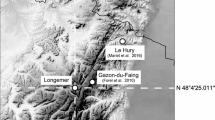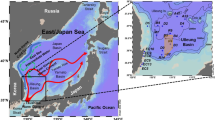Abstract
This paper presents a large palaeolimnological study of the pre-industrial and industrial history of atmospheric lead pollution deposition in Sweden. Both lead concentrations and 206Pb/207Pb ratios have been analysed in 31 lakes covering most of Sweden, plus one lake in north-west Russia. Four of the lakes have varved (annually-laminated) sediments. Isotope analysis is a sensitive and effective method to distinguish pollution lead from natural catchment lead and to detect early pollution influence, because the 206Pb/207Pb ratio in unpolluted background sediments in Sweden was > 1.3, while that of lead from pollution, derived from ores and coal, was < 1.2. The sediments show a consistent picture of past temporal changes in atmospheric lead pollution. These changes include: the first traces of pollution 3,500-3,000 yrs ago; a pollution peak in Greek-Roman Times (about 0 AD); lower lead fall-out between 400 and 900 AD; a significant and permanent increase in atmospheric lead fall-out from about 1000 AD; an increase with the Industrial revolution; a major increase following World War II; the maximum peak in the 1970s; and decreasing fall-out over the last decades. The four varved sediments provide high-resolution records of atmospheric pollution. They reveal pollution peaks about 1200 and 1530 AD which match the history of metal production in Europe. According to the varve records the lead pollution level in the late 1990s had decreased beneath the level of the 1530s. The pollution level 1200 AD was about 35% of the 1980s, when lead pollution was still near its all time high. About 50% of the total accumulated atmospheric lead pollution deposition through time was deposited in the pre-industrial period. The sediments also show a consistent picture of the geographic distribution of atmospheric lead deposition over time, with higher deposition in south Sweden and declining levels to the north, which supports the hypothesis that the main sources of pre-industrial atmospheric lead pollution in Sweden were cultural areas in mainland Europe and Great Britain.
Similar content being viewed by others
References
Alderton, D. H. M., 1985. Sediments. In Monitoring and Assessment Research Centre, University of London (ed.), Historical monitoring. Marc Report 31: 1–86. University of London.
Bacon, J. R., K. C. Jones, S. P. McGrath & A. E. Johnston, 1996. Isotopic character of lead deposited from the atmosphere at a grassland site in the United Kingdom since 1860. Environ. Sci. Technol. 30: 2511–2518.
Bartnicki, J., 1998. Heavy Metals Eulerian Transport Model-HMET. Model description and results. Research Report No. 65. Norwegian Meteorological Institute. Oslo, Norway.
Bindler, R., M.-L., Brännvall, I. Renberg, O. Emteryd & H. Grip, 1999. Natural lead concentrations in pristine boreal forest soils and past pollution trends: a reference for critical load models. Environ. Sci. Technol. 33: 3362–3367.
Blanchard, I., 1976. English lead and the international bullion crisis of the 1550s. In Coleman, D. C. & A. H. John (eds), Trade, Government and Economy in Pre-Industrial England. Weidenfeld, London: 21–44.
Brännvall, M.-L., R. Bindler, O., Emteryd, M. Nilsson & I. Renberg, 1997. Stable isotope and concentration records of atmospheric lead pollution in peat and lake sediments in Sweden. Water Air Soil Pollut. 100: 243–252.
Brännvall, M.-L., R. Bindler, O. Emteryd & I. Renberg, 2000. Vertical distribution of atmospheric pollution lead in Swedish boreal forest soils. Water Air Soil Pollut.
Brännvall, M.-L., R. Bindler, I. Renberg, O. Emteryd, J. Bartnicki & K. Billström, 1999. The Medieval metal industry was the cradle of modern large-scale atmospheric lead pollution in northern Europe. Environ. Sci. Technol. 33: 3362–3367.
Brill, R. H. & J. M. Wampler, 1967. Isotope studies of ancient lead. Am. J. of Archaeol. 71: 63–77.
Brown, J. S., 1962. Ore leads and isotopes. Econom. Geology 57: 673–720.
Burt, R., 1995. The transformation of the non-ferrous metals industries in the seventeenth and eighteenth centuries. Econ. History Rev. 48: 23–45.
Dietz, R., J. Pacyna & D. J. Thomas, 1998. Heavy metals. InAMAP, Artic monitoring and assessment program, Oslo 373–524.
Ek, A., S. I. Renberg. In review. Heavy metal pollution and lake acidity changes caused by one thousand years of copper mining at Falun, Central Sweden. J. Paleolim.
Elbaz-Poulichet, F., P. Holliger, J. M. Martin & D. Petit, 1986. Stable lead isotopes ratios in major French rivers and estuaries. Sci. Tot. Environ. 54: 61–76.
Farmer, J. G., L. J. Eades, A. B. MacKenzie, A. Kirika & T. E. Bailey-Watts, 1996. Stable lead isotope record of lead pollution in Loch Lomond sediments since 1630 AD. Environ. Sci. Technol. 30: 3080–3083.
Faure, G., 1986. Principles of isotope geology. John Wiley & Sons, New York.
Gottfried, R. S., 1983. The Black Death: Natural and Human Disaster in Medieval Europe. Robert Hale, London.
Grousset, F. E., C. R. Quétel, B. Thomas, P. Buat-Ménard, O. F. X. Donard & A. Bucher, 1994. Transient Pb isotopic signatures in the western European atmosphere. Environ. Sci. Technol. 28: 1605–1608.
Grögler, N., J. Geiss, M. Grünenfelder & F. G. Houtermans, 1966. Isotopenuntersuchungen zur Bestimmung der Herkunft römischer Bleirohre und Bleibarren. Naturforschg. 21a: 1167–1172.
Hong, S., J.-P. Candelone, C. C. Patterson & C. F. Boutron, 1994. Greenland ice evidence of hemispheric lead pollution two millennia ago by Greek and Roman civilisations. Science 265: 1841–1843.
Hong, S., J.-P. Candelone, C. C. Patterson & C. F. Boutron, 1996. History of ancient copper smelting pollution during Roman and Medieval times recorded in Greenland ice. Science 272: 246–248.
Hopper, J. F., H. B. Ross, W. T. Sturges & L. A. Barrie, 1991. Regional source discrimination of atmospheric aerosols in Europe using the isotopic composition of lead. Tellus 43B: 45–60.
Horlick, G. & Y. Shao, 1993. Inductively coupled plasma-mass spectrometry for elemental analysis. In Montaser, A. & D. W. Golightly (eds), Inductively Coupled Plasmas in Analytical Atomic Spectrometry, 2nd edition. VCH, New York: 551–676.
Johnson, C. E., T. G. Siccama, C. T. Driscoll, G. E. Likens & R. E. Moeller, 1995. Changes in lead biogeochemistry in response to decreasing atmospheric inputs. Ecol. Appl. 5: 813–822.
Johansson, Å. & D. Rickard, 1985. Some new lead isotope determinations from the Proterozoic sulfide ores of Central Sweden. Mineral. Deposita 20: 1–7.
Keinonen, M., 1992. The isotope composition of lead in man and the environment in Finland 1966–1987: isotope ratios of lead as indicators of pollutant source. Sci. Tot. Environ. 113: 251–268.
Kempter, H., M. Görres & B. Frenzel, 1997. Ti and Pb concentrations in rainwater-fed bogs in Europe as indicators of past anthropogenic activities. Water Air Soil Pollut. 100: 367–377.
Lindroth, S., 1955. Gruvbrytning och kopparhantering vid Stora Kopparberget intill 1800-talets början. Del I och del II. Almqvist & Wiksell, Uppsala, Sweden, 699 pp. and 454 pp. (in Swedish).
Martínez-Cortizas, A., X. Pontevedra-Pombal, J. C. Nóvoa Muños & García-Rodeja, 1997. Four thousand years of atmospheric Pb, Cd and Zn deposition recorded by the ombrotrophic peat bog of Penido Vello (northernwestern Spain). Water Air Soil Pollut. 100: 387–403.
Martínez-Cortizas, A., X. Pontevedra-Pombal, E. García-Rodeja, J. C. Nóvoa & W. Shotyk, 1999. Mercury in a Spanish peat bog: archive of climate change and atmospheric metal deposition. Science 284: 939–942.
Molenda, D., 1976. Investments in ore mining in Poland from the 13th to the 17th centuries. J. European Econ. History 5: 151–169.
Monna, F., D. B. Othman & J. M. Luck, 1995. Pb isotopes and Pb, Zn and Cd concentrations in the rivers feeding a costal pond (Thau, southern France): constraints on the origin(s) and flux(es) of metals. Sci. Tot. Environ. 166: 19–34.
Monna, F., J. Lancelot, I. W. Croudace, A. B. Cundy & J. T. Lewis, 1997. Pb isotopic composition of airborne particulate material from France and the southern United Kingdom: implications or Pb pollution sources in urban areas. Environ. Sci. Technol. 31: 2277–2286.
Murozumi, M., T. J. Chow & C. Patterson, 1969. Chemical concentrations of pollutant lead aerosols, terrestrial dusts and sea salts in Greenland and Antarctic snow strata. Geochim. Cosmochim. Acta 33: 1247–1294.
Nef, J. V., 1987. Mining and metallurgy in medieval civilisation. In Postan, M. M. & E. Miller (eds), The Cambridge Economic History of Europe II. Trade and Industry in the Middle Ages, 2nd edition. U. P. Cambridge, 691–760.
Nriagu, J., 1983. Lead and Lead Poisoning in Antiquity. Wiley-Interscience Publication, New York.
Puchelt, H., U. Kramar, G. L. Cumming, D. Krstic, T. H. Nöltner, M. Schöttle & V. Schweikle, 1993. Anthropogenic Pb contamination of soils, southwest Germany. Appl. Geochem. 2: 71–73.
Renberg, I., 1981. Improved methods for sampling, photographing and varve-counting of varved lake sediments. Boreas 10: 255–258.
Renberg, I., M. Wik Persson & O. Emteryd, 1994. Pre-industrial atmospheric lead contamination detected in Swedish lake sediments. Nature 368: 323–326.
Renberg, I., M.-L. Brännvall, R. Bindler & O. Emteryd, 2000. Atmospheric lead pollution history during four millennia (2000 BC-2000 AD). Ambio 29: 152–158.
Rohl, B. M., 1996. Lead isotope data from the isotrace laboratory, Oxford: Archaeometry data base 2, galena from Britain and Ireland. Archaeometry 1: 165–180.
Rosman, K. J. R., W. Chisholm, S. Hong, J.-P. Candelone & C. F. Boutron, 1997. Lead from Carthaginan and Roman Spanish mines isotopically identified in Greenland ice dated from 600 BC-300 AD Environ. Sci. Technol. 31: 3413–3416.
Rühling, Å., E. Steinnes & T. Berg, 1996. Atmospheric Heavy Metal Deposition in Northern Europe 1995. Nord 1996: 37. Nordic Council of Ministers, Copenhagen. 46 pp.
Settle, D. & C. C. Patterson, 1980. Lead in Albacore: guide to lead pollution in Americans. Science 207: 1167–1176.
Shirahata, H., R. W. Elias & C. C. Patterson, 1980. Chronological variations in concentrations and isotopic compositions of anthropogenic atmospheric lead in sediments of a remote subalpine pond. Geochim. Cosmochim. Acta 44: 149–162.
Shotyk, W., D. Weiss, P. G. Appleby, A. K. Cheburkin, R. Frei, M. Gloor, J. D. Kramers, S. Reese & W. O. Van der Knaap, 1998. History of Atmospheric lead deposition since 12,370 14C yr BP from a peat bog, Jura Mountains, Switzerland. Science 281: 1635–1640.
Stos-Gale, Z., N. H. Gale, J. Houghton & R. Speakman, 1995. Lead isotope data from the isotrace laboratory, Oxford: Archaeometry data base 1, ores from the western Mediterranean. Archaeometry 37: 407–415.
Stuiver, M. & P. J. Reimer, 1993. High-precision decadal calibration of the radiocarbon time scale, AD 1950–6000 BC. Radiocarbon 35: 215–230.
Sugden, C. L., J. G. Farmer & A. B. MacKenzie, 1993. Isotopic ratios of lead in contemporary environmental material from Scotland. Environ. Geochem. Health 15: 59–65.
Véron, A. J. & T. M. Church, 1997. Use of stable lead isotopes and trace metals to characterize air mass source into the eastern North Atlantic. J. Geophys. Res. 102: 28,049–28,058.
Volden, T., C. Reimann, V. A. Pavlov, P. de Caritat & M. Äyräs, 1997. Overbank sediments from the surroundings of the Russian nickel mining and smelting industry on the Kola Peninsula. Environ. Geology 32: 175–185.
Wedepohl, K. H., M. H. Delevaux & B. R. Doe, 1978. The potential source of lead in the Permian kupferschiefer bed of Europe and some selected Paleozoic mineral deposits in the Federal Republic of Germany. Contrib. Mineral. Petrol. 65: 273–281.
Wedepohl, K. H. & A. Baumann, 1997. Isotope composition of Medieval lead glasses reflecting early silver production in Central Europe. Mineralium Deposita 32: 292–295.
Weiss, D., W. Shotyk, A. K. Cheburkin, M. Gloor & S. Reese, 1997. Atmospheric lead deposition from 12400 to ca. 2000 yrs BP in a peat bog profile, Jura mountains, Switzerland. Water Air Soil Pollut. 100: 311–324.
Author information
Authors and Affiliations
Rights and permissions
About this article
Cite this article
Bränvall, ML., Bindler, R., Emteryd, O. et al. Four thousand years of atmospheric lead pollution in northern Europe: a summary from Swedish lake sediments. Journal of Paleolimnology 25, 421–435 (2001). https://doi.org/10.1023/A:1011186100081
Issue Date:
DOI: https://doi.org/10.1023/A:1011186100081




